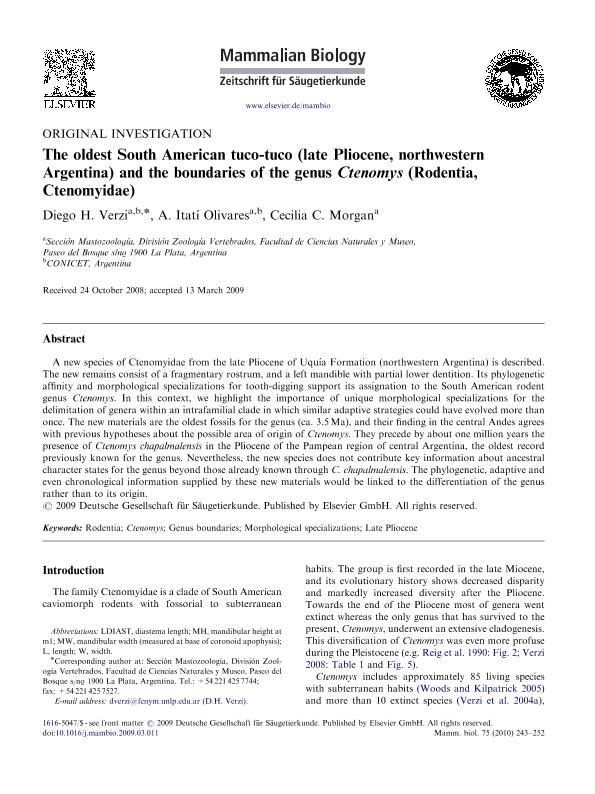Mostrar el registro sencillo del ítem
dc.contributor.author
Verzi, Diego Hector

dc.contributor.author
Olivares, Adriana Itati

dc.contributor.author
Morgan, Cecilia Clara

dc.date.available
2021-02-12T03:07:02Z
dc.date.issued
2010-05
dc.identifier.citation
Verzi, Diego Hector; Olivares, Adriana Itati; Morgan, Cecilia Clara; The oldest South American tuco-tuco (late Pliocene, northwestern Argentina) and the boundaries of the genus Ctenomys (Rodentia, Ctenomyidae); Elsevier Gmbh; Mammalian Biology; 75; 3; 5-2010; 243-252
dc.identifier.issn
1616-5047
dc.identifier.uri
http://hdl.handle.net/11336/125546
dc.description.abstract
A new species of Ctenomyidae from the late Pliocene of Uquía Formation (northwestern Argentina) is described. The new remains consist of a fragmentary rostrum, and a left mandible with partial lower dentition. Its phylogenetic affinity and morphological specializations for tooth-digging support its assignation to the South American rodent genus Ctenomys. In this context, we highlight the importance of unique morphological specializations for the delimitation of genera within an intrafamilial clade in which similar adaptive strategies could have evolved more than once. The new materials are the oldest fossils for the genus (ca. 3.5 Ma), and their finding in the central Andes agrees with previous hypotheses about the possible area of origin of Ctenomys. They precede by about one million years the presence of Ctenomys chapalmalensis in the Pliocene of the Pampean region of central Argentina, the oldest record previously known for the genus. Nevertheless, the new species does not contribute key information about ancestral character states for the genus beyond those already known through C. chapalmalensis. The phylogenetic, adaptive and even chronological information supplied by these new materials would be linked to the differentiation of the genus rather than to its origin. © 2009 Deutsche Gesellschaft für Säugetierkunde.
dc.format
application/pdf
dc.language.iso
eng
dc.publisher
Elsevier Gmbh

dc.rights
info:eu-repo/semantics/openAccess
dc.rights.uri
https://creativecommons.org/licenses/by-nc-sa/2.5/ar/
dc.subject
CTENOMYS
dc.subject
GENUS BOUNDARIES
dc.subject
LATE PLIOCENE
dc.subject
MORPHOLOGICAL SPECIALIZATIONS
dc.subject
RODENTIA
dc.subject.classification
Paleontología

dc.subject.classification
Ciencias de la Tierra y relacionadas con el Medio Ambiente

dc.subject.classification
CIENCIAS NATURALES Y EXACTAS

dc.title
The oldest South American tuco-tuco (late Pliocene, northwestern Argentina) and the boundaries of the genus Ctenomys (Rodentia, Ctenomyidae)
dc.type
info:eu-repo/semantics/article
dc.type
info:ar-repo/semantics/artículo
dc.type
info:eu-repo/semantics/publishedVersion
dc.date.updated
2020-12-04T18:43:36Z
dc.journal.volume
75
dc.journal.number
3
dc.journal.pagination
243-252
dc.journal.pais
Alemania

dc.description.fil
Fil: Verzi, Diego Hector. Universidad Nacional de La Plata. Facultad de Ciencias Naturales y Museo. División Zoología de Vertebrados. Sección de Mastozoología; Argentina. Consejo Nacional de Investigaciones Científicas y Técnicas. Centro Científico Tecnológico Conicet - La Plata; Argentina
dc.description.fil
Fil: Olivares, Adriana Itati. Universidad Nacional de La Plata. Facultad de Ciencias Naturales y Museo. División Zoología de Vertebrados. Sección de Mastozoología; Argentina. Consejo Nacional de Investigaciones Científicas y Técnicas. Centro Científico Tecnológico Conicet - La Plata; Argentina
dc.description.fil
Fil: Morgan, Cecilia Clara. Universidad Nacional de La Plata. Facultad de Ciencias Naturales y Museo. División Zoología de Vertebrados. Sección de Mastozoología; Argentina. Consejo Nacional de Investigaciones Científicas y Técnicas. Centro Científico Tecnológico Conicet - La Plata; Argentina
dc.journal.title
Mammalian Biology

dc.relation.alternativeid
info:eu-repo/semantics/altIdentifier/doi/https://doi.org/10.1016/j.mambio.2009.03.011
dc.relation.alternativeid
info:eu-repo/semantics/altIdentifier/url/https://www.sciencedirect.com/science/article/abs/pii/S1616504709000469
Archivos asociados
